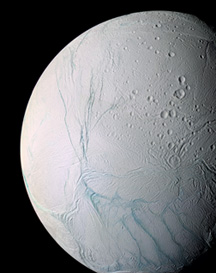Geotimes

Untitled Document

News Notes
Planetary geology
A watery moon?
 Early last year, images from NASA’s Cassini spacecraft revealed a huge
plume of water-ice spewing from Enceladus, a tiny moon orbiting Saturn. For
more than a year, astronomers have been piecing together evidence and they are
finding that the plume stems from underground, indicating that Enceladus is
one of the few objects in the solar system known to support active volcanism.
Early last year, images from NASA’s Cassini spacecraft revealed a huge
plume of water-ice spewing from Enceladus, a tiny moon orbiting Saturn. For
more than a year, astronomers have been piecing together evidence and they are
finding that the plume stems from underground, indicating that Enceladus is
one of the few objects in the solar system known to support active volcanism.
This
false-color image emphasizes cracks in Enceladus’ surface through which
a water-ice plume escapes. The younger surface of the southern hemisphere, made
evident by geologic activity and cracks, contrasts the older cratered surface
of the northern hemisphere. Image is courtesy of NASA/JPL/Space Science Institute.
The discovery that a moon seven times smaller than Earth’s moon could
sustain geologic activity came as a surprise to some astronomers (see Geotimes,
February 2006). Initial surprise, however, gave way to the formulation of
new models to explain the activity.
Publishing in the March 10 Science, Carolyn Porco, the Cassini imaging
team leader at the Space Science Institute in Boulder, Colo., and colleagues
describe the physical processes that they think produce the Old Faithful-like
geyser at the moon’s southern pole.
Porco first looked at the images from Cassini’s three flybys in 2005 and
thought that the plume stemmed from cracks near the moon’s southern pole.
But planetary geologists also had not ruled out that the geyser formed from
the sun warming the icy surface and producing vapors, which could then condense
into a plume in a process similar to the formation of a comet’s tail.
The new models show, however, that the most likely source of the geyser is an
underground reservoir of liquid water. They demonstrated that subsurface liquid
water erupting at the surface could explain the observed dynamics of particles
in the plume, similar to the way Yellowstone’s Old Faithful works.
“Almost undoubtedly,” some mechanism is needed “where you can
get liquid water,” says Peter Thomas, a senior research associate at the
Cornell Center for Radiophysics and Space Research in Ithaca, N.Y. Cassini measured
temperatures on Enceladus’ surface to be well below freezing, “not
warm enough to drive the plume,” Thomas says. Below the surface, however,
models suggest that warmer temperatures could sustain liquid water. Similar
to processes on Earth, that water could boil, and if a crack forms in the ice,
it could erupt as a plume of ice and gas.
Still, the model and images turn up new questions about the range of geologic
features observed on Enceladus, such as why geologic activity is currently limited
to the southern pole. The density of surface craters show that geologic activity
has been present on Enceladus for more than 4 billion years, according to Porco,
but the surfaces at the south are as young as a half a million years.
Remnants of old craters remain on most of the planet, but the southern pole
is “littered” with house-sized ice boulders, “straddled”
with 130-kilometer-long fractures and nearly free of craters, Porco and colleagues
wrote. One possibility is that a nonuniform interior — created by the moon’s
original formation, subsequent tectonics, gravitational forces or some other
process — concentrates heating at the southern pole.
To find out, Thomas says that researchers will need to more deeply analyze specific
tectonic patterns and associated stresses. But what’s currently apparent,
Thomas says, is that Enceladus’ interior is far from a “perfect onion
skin model,” and contains “all different types of geology.”
The amount of subsurface liquid water is likely small, Thomas says, but a gravity
survey of the moon could help “nail down” where water might exist
in its interior. “It’s a whole different way of hunting for water,”
Thomas says. “Apparently, there are many ways to hide liquid water.”
Kathryn Hansen
Links:
"Tiny moon, gigantic geyser,"
Geotimes, February 2006
Back to top
Untitled Document

 Early last year, images from NASA’s Cassini spacecraft revealed a huge
plume of water-ice spewing from Enceladus, a tiny moon orbiting Saturn. For
more than a year, astronomers have been piecing together evidence and they are
finding that the plume stems from underground, indicating that Enceladus is
one of the few objects in the solar system known to support active volcanism.
Early last year, images from NASA’s Cassini spacecraft revealed a huge
plume of water-ice spewing from Enceladus, a tiny moon orbiting Saturn. For
more than a year, astronomers have been piecing together evidence and they are
finding that the plume stems from underground, indicating that Enceladus is
one of the few objects in the solar system known to support active volcanism.

